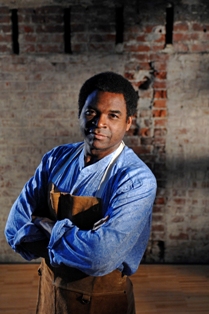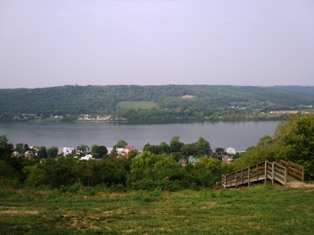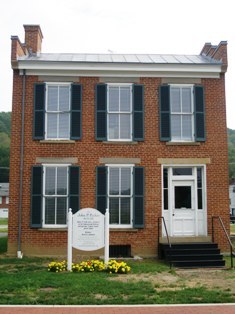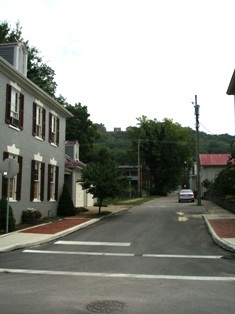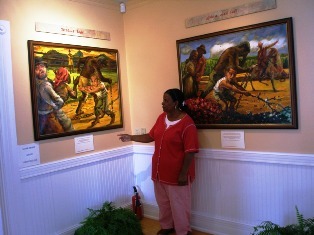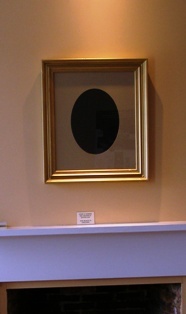Abolitionist History Turned into Song
Mary Ellyn Hutton
Posted: Oct 12, 2007 - 12:00:00 AM in
news_2007
Terry Cook as John P. Parker in Adolphus Hailstork's "Rise for Freedom." Photo courtesy of Cincinnati Opera
Ripley, Ohio, population 1,822 (2004 estimate), 53.1 miles east
of Cincinnati on the Ohio River, once played a very big role in American
history.
Little Ripley, now a quiet village in Brown County,
was on the front lines of the "war before the war," the strife over
slavery that led to the Civil War.
A glance at the map tells the story: Ripley nestles on a hillside
just across the river from Dover, Ky. Once bustling with river
traffic, it was a natural point of entry for slaves seeking freedom in the north.
The Ohio River from Ripley Ohio (John Rankin house)
Founded in 1803, Ripley was also home to a community of citizens
who led the fight against slavery. One of them, John P. Parker, is the subject
of a new opera commissioned by Cincinnati Opera - "Rise for Freedom,"
by Adolphus Hailstork, libretto by David Gonzalez - to be given its world
premiere Oct. 13-21 in Jarson-Kaplan Theater at the Aronoff Center
for the Arts, downtown.
Heading the cast is renowned bass Terry Cook as Parker. Soprano
Andrea Jones-Sojola sings Parker's wife Miranda, with tenor Daniel Weeks as the Rev. John Rankin, baritone Jeremy Cady as the slave owner Sroufe and tenor Jeremy Cady and soprano Kearstin Piper Brown as Mr. and Mrs. McDowell, a couple enslaved by Sroufe.
The opera is fully staged and scored for a 17-piece chamber orchestra with Kentucky Symphony Orchestra music director James R. Cassidy leading members of the KSO. Billed as a family show (grades 4 and up), the
opera is also being performed in several area schools. Stage director is Sheila
Ramsey, artistic director of Dayton's Dream Keeper Theatre Company.
Parker was a leading conductor on the Underground Railroad -
which, incidentally, got its name in 1831 in Ripley, when a frustrated slave
owner, unable to find his vanished "property," remarked that he must
have disappeared on an "underground road."
"Ripley had a real strong network of URR conductors," said Betty Campbell, president of Ripley Heritage, Inc. So many that Confederate officers threatened to burn it to the ground during the Civil War and referred to it as "that abolitionist hellhole." The Ripley Anti-Slavery Society, co-founded by Rankin, had over 300 members.
The son of a black woman and a white man, Parker helped hundreds
of fugitives cross into the free state of Ohio. Born in Norfolk, Va., in 1827, he was separated from his mother and sold at age 8 to a doctor in Mobile, Ala. Taught to read by the doctor's family, he made several failed attempts to escape, then was sold to a widow, who allowed him to buy his freedom
for $1,800. Working as an iron molder, he paid her in just 18 months and at the
age of 18, headed north.
Parker lived a short time in Cincinnati, where he met and married
Miranda Boulden, then in 1849, moved to Ripley where they raised six children
and lived on Front Street, practically where the waves lap the shore today.
(The Ohio River was much shallower then and about half as wide as it is today. The Corps of Engineers installed locks and dams to improve
John P. Parker House, Front Street, Ripley, Ohio
navigation, beginning in the 1920s. A successful businessman, Parker owned and operated his own Phoenix Foundry and Machine Company, where he employed more than 25 workers, black and white.
"He lived right on the edge of danger," said Peggy
Mills Warner, tour guide at the John P. Parker House in Ripley, now a National
Historic Landmark. "He would take a boat across the river and beckon
people to come to freedom. He didn't have to be invited. He would just urge
them that there's a better way than living in bondage."
Once on the Ohio shore, Parker guided his charges to the Rev. Rankin's house on top of the hill in Ripley (also a National Historic Landmark) or to safe havens elsewhere in town, after which they would be led to freedom in Canada. Rankin, a Presbyterian minister whose 1826 "Letters on American Slavery" helped spark the abolitionist movement, kept a lamp in his
View from Front Street in Ripley of abolitionist John Rankin's house (atop the hillside on the left)
window at night as a beacon for escapees.
"A conductor took slaves from one person to another," said Warner. "And they had to be back home before dawn, because if they were missed, people would go ahead and charge them."
Peggy Mills Warner, tour guide, John P. Parker House, with paintings depicting images from Parker's life.
Partly indicative of the secrecy in which Underground Railroad conductors worked, no photo of Parker has ever been found, she said. In testament and until one surfaces an empty frame is kept over the mantel in the front room of the Parker house.
Empty photo frame in John P. Parker House in Ripley
"He had tremendous courage," said librettist Gonzalez, 50, who walked in Parker's shoes in "Finding North," his own one-man play about Parker and other freedom seekers at the Playhouse in the Park in 2004, and actually swam across the Ohio River to see how it might have felt to a fugitive slave.
He based his libretto on Parker's autobiography "His Promised Land," narrated to journalist Frank Moody Gregg during the 1880s as Moody was seeking the true-life Eliza in Harriet Beecher Stowe's "Uncle Tom's Cabin." The manuscript remained unpublished until 1996, after languishing in the Duke
University archives. (Parker alludes to the Eliza story in his autobiography, and
author Ann Hagedorn, now a Ripley resident, provided conclusive evidence in her 2002 book "Beyond the River" that the woman and baby depicted in
Stowe's novel crossed the ice floes between Kentucky and Ripley in 1838 and
took refuge in Rankin's house.)
The opera focuses on a harrowing incident in Parker's life: Dared by a foundry customer (Sroufe) to "run away" one of his slaves, Parker crosses the river and whisks away not only the McDowells, but also their baby, whom Sroufe has kept in his bedroom at night to discourage the parents from fleeing. Parker entrusts his boots to McDowell so he can sneak into the house and rescue the baby, but McDowell drops them during the escape. Sroufe takes the boots to the cobbler in Ripley, who refuses to identify them as Parker's.
Gonzalez, who wrote some of the libretto in Parker's bedroom inRipley, calls him "bigger than life. He's self-educated. He's read Shakespeare (in the opera he reads a Shakespeare sonnet to his children). He was an inventor." (Parker's soil pulverizer, tobacco press and sugar mill were all patented.)
In the opera, Gonzalez gives him "a shading of human vulnerability," as well. "He has some doubt about 'haven't I done enough? I've got a wife and kids.' Miranda steps forward and says, 'This is your calling. This is why we live here. This is what we have to do.' "
Rochester, N.Y., native Hailstork, 66, who in addition to degrees
from Howard University, Manhattan School of Music and Michigan State
University, studied with legendary pedagogue Nadia Boulanger in France, calls
himself "a cultural hybrid" who tries to integrate Eurocentric and African-American music.
"Rise to Freedom" is "very Americana," he said. "This is not urban territory. It's a stretch of humanity living along the river. If I start throwing in sophisticated urban sounds, I think I'd be losing the flavor."
The 15-member cast includes three Parker children (ages 8, 10 and
12), foundry workers, Sroufe's men and the cobbler. The chorus of Ripley
townspeople also acts as a "Greek chorus" that comments on the action
as it happens.
"Gonzalez and Hailstork have done a masterful job of boiling down this piece of local history," said Cassidy. "Not a moment is wasted. There are a couple of altercations between Sroufe and John Parker which are quite dramatic and powerful, very difficult to sing. The duet between John and Miranda is most touching and beautiful." The chorus is used in "big ensemble moments," including a scene in Rev. Rankin's church. "The piece ends on a powerful D-major chord on the word 'Rise,' sung by the former slaves and townspeople," said Cassidy.
"Still, all is not right. Sroufe and his gang add their F-natural on the word 'fight,' creating the dissonance that foreshadows the split in the country."
Performances of Adolphus Hailstork's "Rise for Freedom" are 7 p.m. Saturday, 3 p.m. Sunday and 3 and 7 p.m. Oct. 20 and 21 in Jarson-Kaplan Theater at the Aronoff Center for the Arts downtown. Tickets are $15, $10 for children, available at (513) 241-2742 and at the Corbett Opera Center box office in Music Hall, 1243 Elm Street at the corner of Elm and 14th Streets in Over-the-Rhine, from 9:30 a.m.-5 p.m. Monday through Friday.
Photo of Terry Cook and the John P. Parker house courtesy of Cincinnati Opera. Other photos by Mary Ellyn Hutton.
(first published in The Cincinnati Post Oct. 11, 2007)

